Warm-Up Areas: Optimising Space and Routines for Effective Warm-Ups
Updated On: October 24, 2025 by Aaron Connolly
Definition and Purpose of Warm-Up Areas
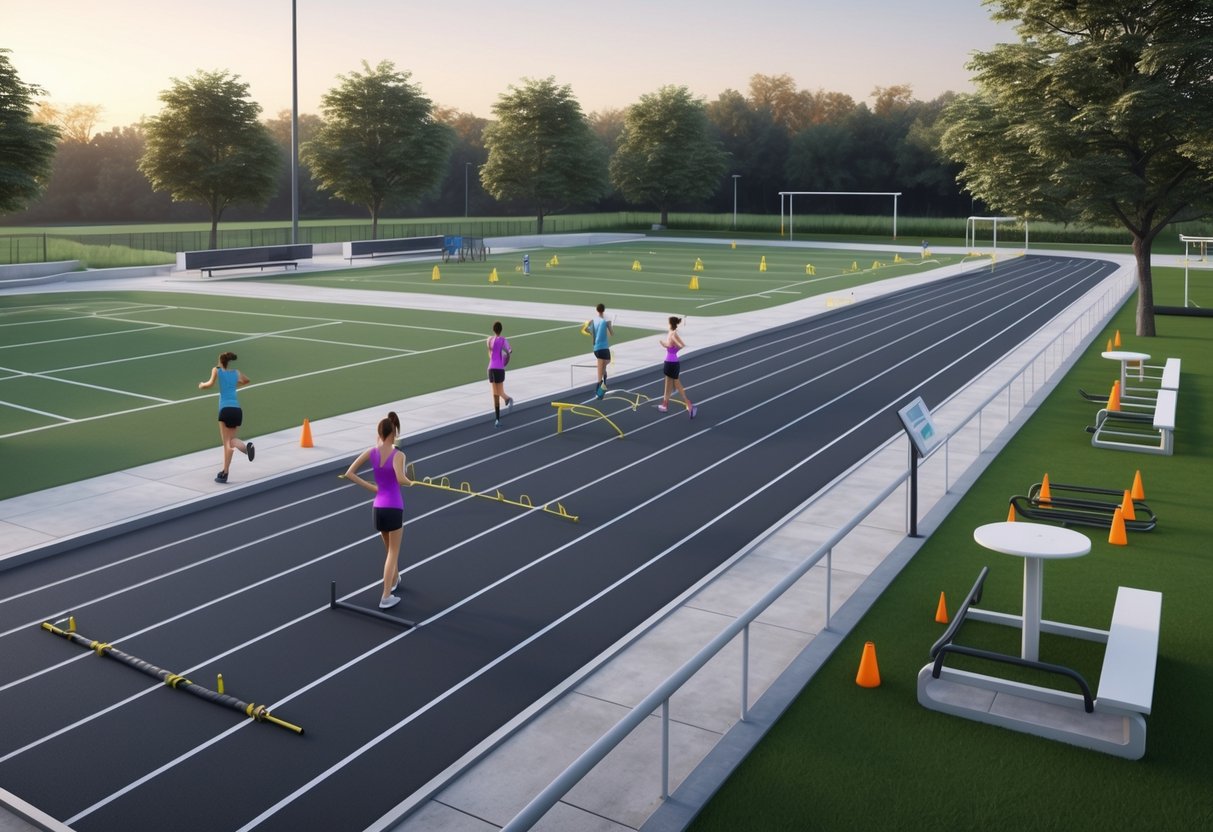
Warm-up areas give athletes and exercisers a place to get their bodies ready for sport or training. People use these spaces for injury prevention, boosting performance, and just getting physically prepped for what’s next.
Key Functions in Exercise Settings
Warm-up areas support the three main phases of proper preparation. In the raise phase, athletes use light movement to get their body temperature, heart rate, and blood flow up. You’ll see people jogging or doing dynamic movements.
The activate and mobilise phase targets important muscle groups and joints. Athletes grab mini-bands, do balance drills, and practice movement patterns they’ll need later. This phase really wakes up the muscles.
In the performance phase, intensity ramps up to match the sport or activity. Athletes do sport-specific drills at game speed. Footballers might sprint; weightlifters might go through their lifts.
A good warm-up area needs enough space for movement in every direction. It should have flooring that lets you jump, land, and change direction safely.
Role in Injury Prevention
Research backs it up: solid warm-ups lower your risk of injury if you do them right. Warm-up areas make this possible by giving you a safe place to get ready.
Dynamic stretching here works better than static stretching. When you move through a range of motion, your nervous system kicks in. This preps your muscles for what’s coming.
Getting warmer helps muscles contract and relax faster. Warm muscles handle exercise demands better and don’t strain as easily.
Heads up: Jogging a few laps around the field isn’t enough anymore. Modern warm-ups need variety and should actually reflect the activity ahead.
Warm-up areas let you start easy and build up to tougher movements. This gradual approach gives your body time to adapt—no sudden shocks.
Warm-Up Areas in Sports Venues
Pro sports venues design warm-up areas for their own needs. Football stadiums set aside spaces for players to run drills before games, often using surfaces similar to the main field.
Gyms set aside floor space for warm-ups too. The best ones give you enough room to move and supply things like resistance bands and foam rollers.
Many venues keep warm-up areas separate from the main action. This way, people warming up don’t bump into those already training, and everyone stays safer.
Quick tip: When picking a training spot, check if it has a dedicated warm-up area. Trying to warm up in a cramped space just doesn’t work.
Some places offer guided warm-up sessions. These help people learn good technique and make sure everyone gets enough prep time.
Types of Warm-Up Areas

Esports venues need specific warm-up spaces so players can get ready mentally and physically before matches. You’ll find everything from fully kitted-out indoor rooms to quick, temporary setups at tournaments.
Indoor Warm-Up Spaces
Most pro esports facilities have dedicated practice rooms that are separate from the main competition area. These rooms usually have the same gaming gear as the match stage.
You’ll notice they use identical monitors, keyboards, and mice as the competition. This way, players won’t have to adjust to new equipment when it matters most.
Climate control matters a lot. Players need a stable temperature and humidity to stay sharp.
| Feature | Professional Setup | Budget Setup |
|---|---|---|
| Gaming PCs | Identical to match specs | Similar performance level |
| Monitors | Same brand/model as main stage | 144Hz minimum |
| Peripherals | Exact match equipment | Compatible alternatives |
A lot of indoor warm-up areas use soundproofing to block out distractions. This lets players focus on their routines.
Outdoor Warm-Up Zones
Big tournaments sometimes set up temporary outdoor practice areas if they don’t have enough indoor space. These spots need extra weather protection and equipment security.
Covered tents or pavilions keep gaming gear safe from rain and sun. Organisers use pro-grade weather barriers to keep things stable.
Outdoor power setups get tricky. Organisers run special electrical lines to make sure all the gaming stations work safely.
Equipment protection is a must. Dust covers, moisture barriers, and secure mounts keep expensive gear safe.
Security gets tighter outside. Staff keep an eye on both personal and tournament equipment to prevent theft or tampering.
Mobile and Temporary Setups
Portable warm-up stations come in handy for smaller events or tight spaces. You can set these up and take them down fast between tournament days.
Rolling equipment carts make it easy to rearrange practice spaces. Staff can switch up the layout depending on how many teams need to warm up.
Modular furniture systems give you flexibility. Fighting game setups need different space and gear compared to team strategy games.
Temporary setups usually rely on wireless internet backup systems to keep connections stable. It’s smart to have more than one internet source, just in case.
Lots of mobile setups use noise-dampening panels around practice stations. That way, players can focus even if the venue is busy.
Essential Features of Warm-Up Areas
A solid warm-up area brings together safety, good surfaces, and enough space to get ready properly. These elements work hand-in-hand to help prevent injuries and boost performance.
Safety and Accessibility
Safety starts with clear sight lines across the warm-up zone. Athletes need to see what’s going on, and coaches need to keep an eye on everyone.
Emergency access always matters. The area should connect to main exits without forcing people through crowded spots.
Lighting needs to be even, with no shadows or glare. Bad lighting can cause trips, falls, and sloppy warm-ups.
Key safety features:
- Non-slip surfaces for any weather
- Rounded corners on equipment and structures
- First aid stations within 30 metres
- Clear emergency procedure signs
Temperature control keeps things comfortable. Extreme heat or cold makes warm-ups less effective and bumps up injury risk.
Storage should be secure but not block walkways. Loose equipment just gets in the way and can cause trips.
Flooring and Surface Considerations
For most warm-up activities, natural or artificial turf works best. The surface should feel like the main playing area so movement patterns stay consistent.
Indoor facilities do well with rubber flooring or synthetic turf. These materials grip well and cushion joints during dynamic moves.
If the surface is too soft, you lose power. Too hard, and your joints take a beating.
What to look for:
- Consistent texture everywhere
- Good drainage for outdoor spots
- Impact absorption for jumping drills
- Easy cleaning to keep things hygienic
Check artificial surfaces often for wear. Damaged spots throw off footing and can cause injuries.
Outdoor areas need weather-resistant surfaces. If things get slippery when wet, warm-ups might get cancelled—frustrating for everyone.
Space and Equipment Requirements
Every warm-up area should measure at least 4m x 20m so five athletes and a coach can move freely. That’s enough space to avoid bumping into each other.
Movement zones need clear boundaries. People in different warm-up phases shouldn’t get in each other’s way.
Basic gear includes:
- Agility markers for drills
- Resistance bands for muscle activation
- Foam rollers for prepping muscles
- Medicine balls for dynamic work
Good storage keeps everything tidy and easy to grab. Built-in storage means less setup time and less clutter.
Ceiling height matters too. Indoors, aim for at least 3 metres so you can jump and stretch without worrying.
Multiple entry points help during busy times. Athletes should get in and out without crossing active zones or interrupting others.
Designing a Warm-Up Area

Designing a good warm-up space takes a bit of planning. You want zones that let people prep properly, but still let groups move around without running into each other.
Planning and Layout Principles
Start simple: figure out how much space you need and what surface works best. Aim for at least 4m x 20m so five people and a coach can move comfortably. Nobody wants to feel cramped during warm-ups.
Surface choice really matters. Go for natural or artificial turf that matches the main playing area. Consistency helps players move right.
Location is a big deal. Put warm-up areas separate from main training spots, but close enough so transitions are easy. Indoors, set aside rooms or mark out clear sections.
Keep equipment storage handy. Wall racks for bands, rollers, and tools keep things tidy. Built-in storage stops clutter from becoming a hazard.
Lighting and ventilation can’t be overlooked. Bright, even light helps players see what they’re doing. Good airflow keeps the space from getting stuffy, especially during group sessions.
Incorporating Functional Zones
Divide the warm-up area into three zones for best results. Each zone does something different.
Zone 1: General Movement (by the entrance) Here’s where people do light cardio and basic moves. Leave this space open—no equipment in the way.
Zone 2: Dynamic Preparation (middle) This is for dynamic stretching and range of motion work. Players need space for leg swings, lunges, and game-specific moves. Add some cones for movement patterns.
Zone 3: Activation (nearest the main training area) This zone focuses on neural activation and stability. Think single-leg stands, core work, and balance drills.
Let each zone flow into the next. Use floor markings, not barriers, to guide people.
Optimising Flow for Groups
Group warm-ups change how you use space. You need to let several people move at once without chaos.
Use clear pathways between zones—different colours or markings help. This keeps things moving during busy sessions.
Stagger timing by designing zones that take longer as you go. General movement goes fast; activation takes more time.
Plan for your group size plus a bit extra. If you usually train 8, make room for 10.
Coaches should stand where they can see everything. One central spot works best.
Don’t let equipment block movement. Wall storage and clear gear zones keep paths open, even at peak times.
Benefits of Using Proper Warm-Up Areas
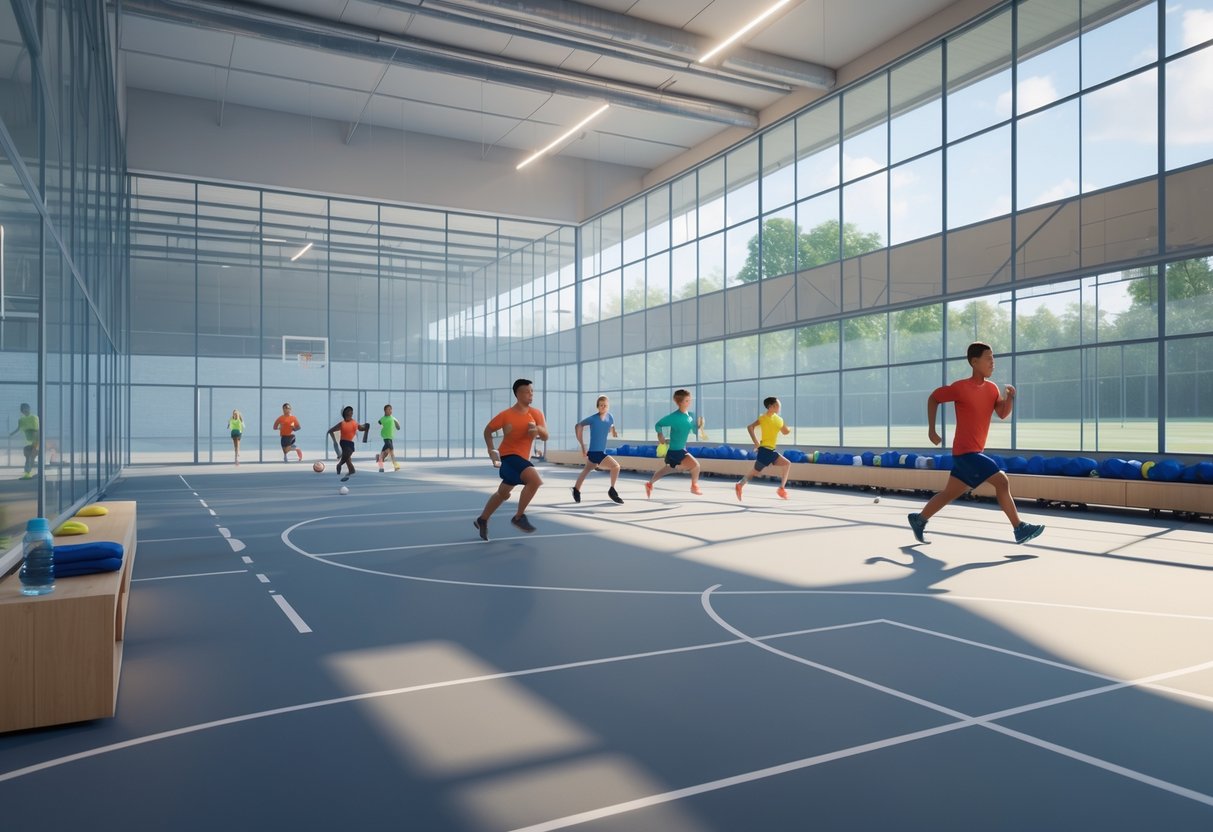
Dedicated warm-up spaces really help players get their bodies ready. These areas help raise muscle temperature, boost energy, and improve performance while cutting down injury risks.
Enhanced Performance
When we have a proper warm-up area, we get the space and tools we need to prep for top performance. In a designated spot, it’s easier to focus on dynamic moves that gradually warm up muscles.
Warmer muscles contract faster and work more efficiently. That means quicker reactions and smoother coordination in-game.
Well-equipped areas usually have foam rollers and resistance bands. These help us activate the right muscles before training and let us target any trouble spots.
The mental benefits matter too. Having a set space to warm up helps us shift from daily distractions to game mode. That focus pays off in better decisions and sharper play.
A lot of pro esports facilities now have their own warm-up zones. Players often say they feel more ready and confident when they use them.
Injury Reduction
Cold muscles strain and injure way more easily. When we have proper warm-up areas, we can avoid these problems by easing into activity in the right environment.
Key injury prevention benefits:
- More blood flowing to muscles
- Joints move better
- Muscles feel less stiff
- Fewer sudden muscle pulls
Gaming means repeating the same motions, which really puts our wrists, shoulders, and neck at risk. With a good warm-up area, we can focus on stretches and exercises for those spots.
Temperature-controlled spaces make a big difference compared to random corners. When the environment stays the same, our bodies know what to expect and respond better to routines.
If you do static stretches after some light movement, you’ll prevent injuries more effectively. Warm-up areas give us the privacy and space to stretch properly, without people interrupting or distractions everywhere.
Support for Energy Production
Our bodies need a good start to make energy efficiently for those marathon gaming sessions. Warm-up areas really help us get there.
Doing light cardio in these spaces raises our heart rate bit by bit. That way, our heart and lungs can send oxygen and nutrients to our muscles just when we need them.
Energy production improvements:
- Blood moves around better
- More oxygen gets to muscles
- Nutrients travel faster
- Waste clears out more easily
Most proper warm-up areas have decent airflow and lighting. That helps us keep up our energy while we get ready.
If we warm up in the same spot each time, our bodies learn the routine. Over time, we use less energy to get the same benefits.
A controlled space lets us focus and keeps our energy steady. We’re not wasting effort dealing with noise or uncomfortable temperatures.
Key Warm-Up Exercises Suited for Dedicated Areas
A proper warm-up area gives you the space to do movements that get your body ready for gaming or any physical activity. The best warm-ups mix movement, mobility, and some easy cardio to wake up your muscles and joints.
Dynamic Activities
Dynamic exercises use movement to prep your muscles and joints for action. You’ll want a dedicated area so you’re not bumping into stuff or tripping over furniture.
Arm circles wake up your shoulders and upper back. Start small, then make the circles bigger. Try 10 forward, then 10 backward.
Leg swings loosen up your hips. Hold onto something, swing your leg forward and back, then side to side. Do 10 each way, then switch legs.
High knees get your heart rate up and warm your legs. March in place, lifting your knees high. Go for about 20 reps per leg.
Butt kicks wake up your hamstrings and glutes. Jog in place, kicking your heels toward your butt. Keep your knees down and do 20 per leg.
Static Stretches and Mobility
Once you’ve moved around a bit, static stretches work better. Hold each stretch for about 15-30 seconds, and don’t bounce.
Neck rolls ease tension in your neck and shoulders. Roll your head in a slow circle, stopping at any tight spots. Do 5 each way.
Shoulder stretches help keep your upper body loose. Pull one arm across your chest and hold it with your other hand. You should feel it across your shoulder.
Hip flexor stretches fight the effects of sitting. Step forward into a lunge and push your hips ahead, keeping your back straight.
Spinal twists boost your back’s mobility. Sit with your legs out, cross one over, and twist toward that side, using your arm for a little extra pressure.
Cardiovascular Warm-Ups
Some light cardio gently raises your heart rate and gets blood moving. These moves prep you for tougher activity.
Marching in place is an easy way to start. Lift your knees to hip height and swing your arms. Keep it going for 1-2 minutes.
Step-ups on a sturdy step or platform work your legs. Step up, then down, switching the lead foot every 10 reps.
Jumping jacks warm up your whole body and get your pulse up fast. Start slow, pick up speed as you go. Shoot for 20-30 reps.
Light dancing or just moving to music makes warming up way more fun. Put on a favorite song and move however feels good. It’s great if you need a longer warm-up.
Popular Warm-Up Movements for All Levels
These three basic moves form the backbone of a good warm-up because they hit a lot of muscles at once. You can tweak each one for beginners or ramp them up if you’re more advanced.
Jumping Jacks and Variants
Jumping jacks are a classic—they get your heart going and help with coordination and rhythm.
Basic jumping jacks mean standing with feet together, jumping out while spreading your legs and raising your arms overhead, then jumping back in. Keep it up for 30-60 seconds.
Star jumps up the intensity—jump higher and spread your arms and legs wider.
Modified versions work if your joints need a break. Step side to side instead of jumping, or do half jacks with just arms or just legs.
Progression tips:
- Begin with 20-30 reps
- Work up to 60 seconds for stamina
- Try changing directions for more challenge
Stay focused on good form. Keep your core tight and land softly.
Bodyweight Squats Techniques
Bodyweight squats get your legs and core ready for action. They wake up your glutes, quads, hamstrings, and core all at once.
Proper form: Stand with feet shoulder-width apart, toes out a bit. Push your hips back, bend your knees, and lower down. Keep your chest up, weight in your heels.
Depth targets: Try to get your hips just below your knees for full activation and better mobility.
Common mistakes: Knees caving in, rising onto your toes, or rounding your back. Push your knees out and keep your torso upright.
Progressions:
- Pulse squats—little bounces at the bottom
- Jump squats—add a hop as you come up
- Single-leg squats—for advanced strength
Start with 10-15 reps, focusing on slow, controlled movement. Quality beats quantity every time.
Planks and Core Activation
Planks fire up your whole core and teach good posture. They set you up for almost any activity by building stability.
Standard plank: Balance on forearms and toes, body straight. Keep elbows under shoulders.
Breathing: Stay relaxed and breathe steadily—don’t hold your breath and tense up.
Form checks:
- Keep your spine neutral
- Squeeze your glutes
- Push shoulders away from the ground
- Brace your abs
Modifications: Drop to your knees or put your hands on a bench to make it easier.
Progressions: Try side planks, plank-to-push-up, or add leg lifts. If you’re advanced, hold for over 60 seconds.
Start with 20-30 seconds, then build up. Two or three sets are usually enough.
Upper and Lower Body Warm-Up Drills
These targeted drills get your muscles ready for gaming and help you stay healthy during long practice sessions. Push-ups get your upper body going, mountain climbers hit your whole body, and mobility work keeps your hips and shoulders loose for good posture.
Push-Ups for Activation
Try starting with push-ups—they wake up your chest, shoulders, and core. You’ll get blood moving before you even sit down to play.
Standard Push-Up Form:
- Keep your body straight
- Lower until your chest almost touches the ground
- Push up with control
Beginner Modifications:
- Wall push-ups
- Knee push-ups
- Incline push-ups with a chair or desk
Start with 5-10 reps. If you’re just starting out, wall push-ups are a great option. Lots of gamers swear by this warm-up for loosening up tight muscles after hours at the desk.
Quick tip: Do a few push-ups between matches to reset your posture and wake up your core.
Mountain Climbers for Full Body
Mountain climbers hit a bunch of muscles at once and get your heart rate up. This move preps your whole body for gaming.
Proper Technique:
- Get into push-up position
- Bring one knee toward your chest
- Switch legs quickly, keeping plank form
- Keep your core tight
Go for 20-30 seconds without stopping. This will get your blood flowing and activate your core stabilisers.
Mistakes to avoid:
- Letting hips sag or pike
- Moving too slow
- Forgetting to breathe
A lot of esports players use mountain climbers as their main warm-up. The move helps with coordination and reaction time.
Mobility for Hips and Shoulders
Sitting for gaming tightens up hips and shoulders. These mobility drills help undo that.
Hip Mobility Sequence:
- Hip circles: 10 each way
- Leg swings: 10 forward and back
- Walking lunges: 5 per leg
Shoulder Mobility Routine:
- Arm circles: 10 forward, 10 backward
- Shoulder shrugs: 10 times
- Cross-body arm stretches: Hold for 15 seconds each
Go slow and stay in control. Focus on feeling the stretch, not forcing it.
Heads up: Don’t stretch cold muscles. Do these after you’ve done push-ups and mountain climbers.
Even pro gamers get stiff shoulders and hips from long sessions. These drills help you keep good posture and avoid common gaming injuries.
Phases of an Effective Warm-Up Routine
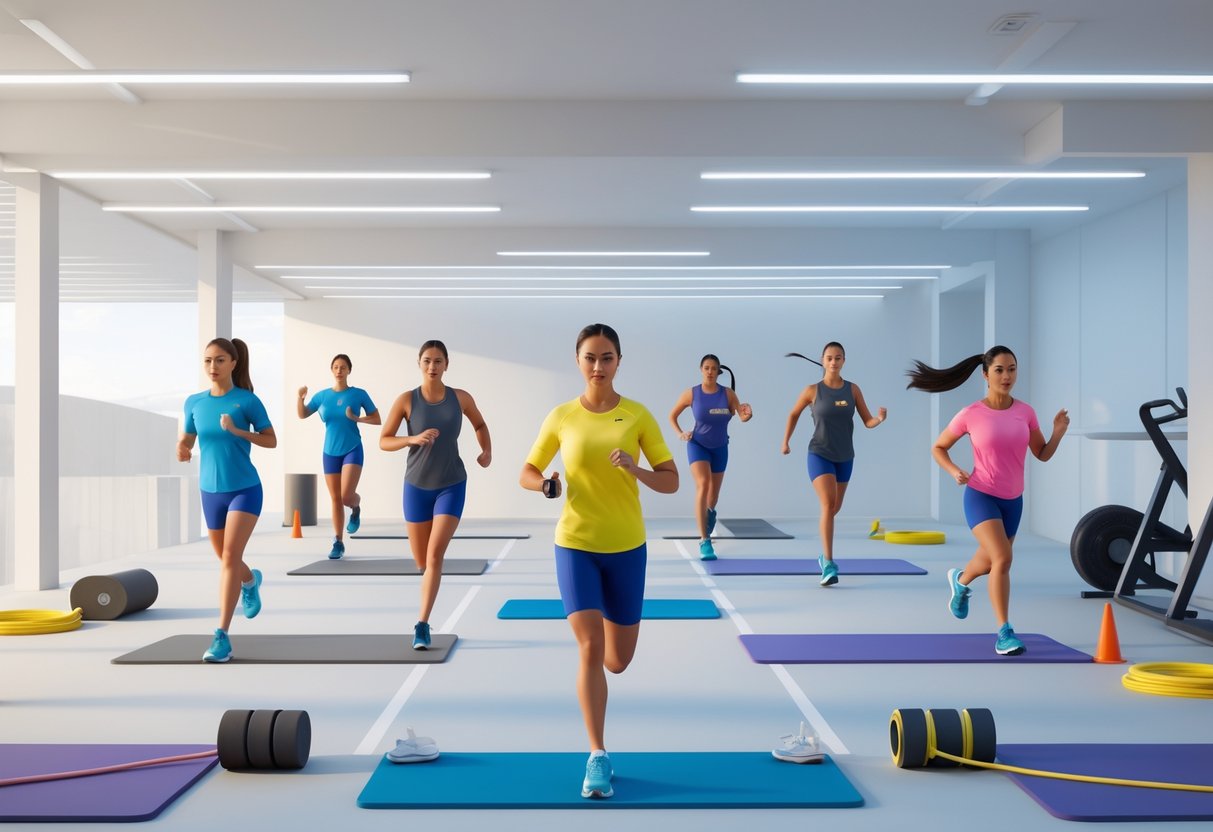
A solid warm-up has three phases that get you ready for intense gaming. Each phase builds on the last to lower injury risk and boost performance.
Raising Core Temperature
First, you want to get your blood moving and your muscles warm. This gets your heart and lungs ready.
Try 5-8 minutes of easy movement. Walking, jogging in place, or simple moves work well. Aim to break a light sweat—not get worn out.
Key activities:
- High knees for 30 seconds
- Gentle arm swings
- Light marching
- Basic jumping jacks
Your heart rate should rise slowly. No need to go all out. Just wake your body up.
Warmer muscles bend and stretch easier. That sets you up for the next stage.
Activating and Mobilising Muscles
Next, focus on the specific muscles and joints you’ll use while gaming. This is where you work on flexibility and switch on important muscle groups.
Upper body work:
- Shoulder rolls (10 forward, 10 back)
- Neck stretches (hold 15 seconds each way)
- Wrist circles and stretches
- Upper back squeezes
Lower body activation:
- Hip circles (10 each way)
- Gentle leg swings
- Ankle rotations
- Light glute bridges
Dynamic moves beat static stretching here. Move through your full range of motion instead of holding still.
Pay extra attention to any stiff spots. If you sit at a desk a lot, you’ll probably need more work on shoulders and hips.
Preparing for Maximum Effort
This final phase bridges the gap between warming up and going all-out. Gradually, you ramp up the challenge to get your nervous system ready.
Start with movements similar to your main activity. If gaming’s your thing, try:
- Faster finger movements
- Quick reaction drills
- Hand-eye coordination exercises
- Slowly increasing intensity
Practice movements include:
- Rapid finger tapping
- Quick hand position changes
- Eye tracking exercises
- Short, high-intensity bursts
Usually, this phase lasts about 3-5 minutes. You’re teaching your body to expect heavier demands.
Your nervous system needs a little time to fully kick in. If you rush, you risk injury and your performance drops.
End this phase feeling sharp and ready. You want to feel warm, loose, and mentally set for what’s next.
Warm-Up Area Guidelines for Different Activities
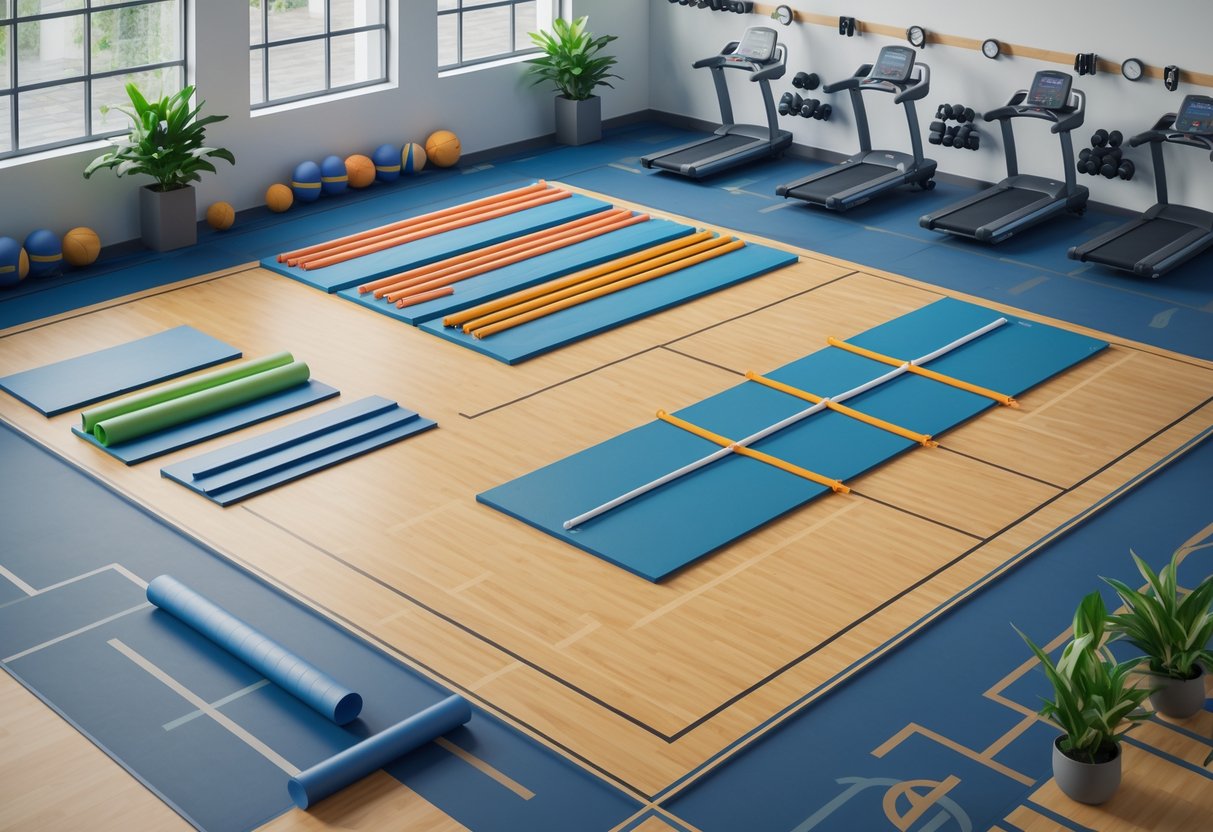
Different sports and activities need their own unique warm-up spaces and routines. Team sports need bigger areas for group movements, while solo activities can get by with less space and just the right equipment.
Team Sports Preparations
Team sports need warm-up areas that match the playing surface. Football and rugby teams work best on turf or grass, with at least a 20m x 4m zone.
Space essentials:
- Room for at least 5 players and coaches
- Same type of surface as the main field
- Clear boundaries away from spectators
- Storage for equipment nearby
Basketball and netball teams can use smaller indoor spaces. Areas of at least 15m x 10m work for ball handling and dynamic drills.
The warm-up should use movements from the sport itself. Football teams go for sprints and ball touches. Rugby squads focus more on contact prep and lineout practice.
Team warm-up structure:
- Tissue prep – foam rolling and stretching (5 minutes)
- Movement patterns – sport-specific drills (8 minutes)
- Activation – bursts of high intensity (4 minutes)
Each player needs about 2-3 square metres for the dynamic parts. That way, no one bumps into each other and everyone can move properly.
Individual Fitness Activities
Solo activities need less space but good equipment placement. Runners can warm up in just 10m x 5m, using high knees and leg swings.
Equipment zones make things easier:
- Foam rolling station – 2m x 3m with storage
- Stretching area – yoga mats and props
- Dynamic movement zone – clear 8m x 4m space
- Activation corner – resistance bands and light weights
Cyclists need a spot for bikes and a bit of room to move. A 3m x 5m zone with bike stands and tools nearby works well.
Strength athletes need more gear. Powerlifters use lighter barbells for warm-ups, and the space should link right to the main training area.
Solo warm-up timing:
- Tissue work: 3-4 minutes
- Mobility: 4-5 minutes
- Activation: 3-4 minutes
Temperature control matters more here. People warm up at their own pace and need to stay comfy, especially at the start.
Recreational and Rehabilitation Needs
Recreational users need flexible spaces for all fitness levels. Weekend warriors often have movement restrictions and need extra care.
Accessibility features to include:
- Non-slip floors everywhere
- Grab rails near stretching spots
- Adjustable equipment heights
- Clear sight lines for supervision
Rehabilitation spaces need more safety. Softer floors and emergency communication systems help a lot.
Equipment for recreational use:
- Foam rollers in different densities
- Light to medium resistance bands
- Stability balls of various sizes
- Props for modified movements
Older adults and people recovering from injuries need longer warm-ups. Aim for 15-20 minute sessions instead of the usual 8-12 minutes.
Group fitness warm-ups work best when the instructor is visible from all angles. Mirrors help people check their form and stay motivated.
The space must fit wheelchairs and mobility aids. At least 1.5m between equipment stations keeps things safe and easy to navigate.
Adapting Warm-Up Areas for Special Groups
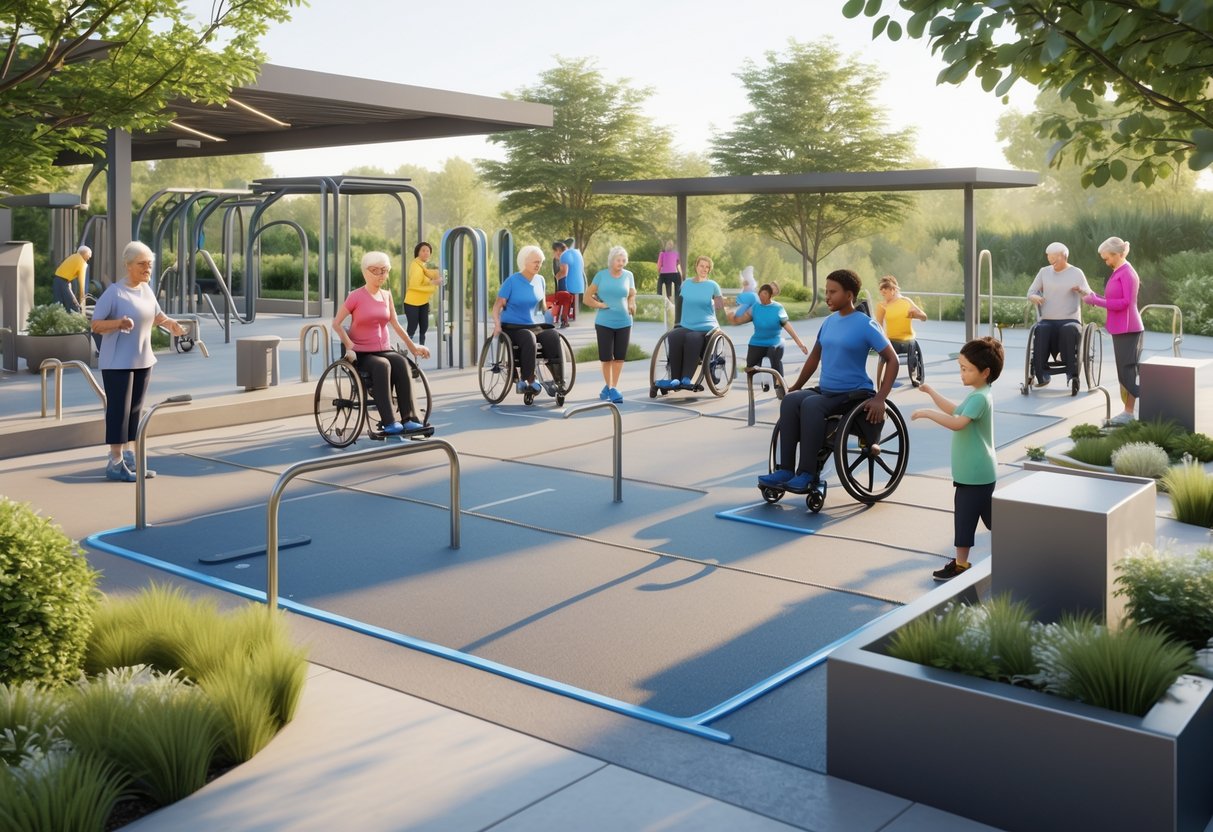
Different groups need different warm-up approaches to stay safe and get the most from training. Age, mobility, and physical ability all shape how we design and use warm-up spaces.
Children and Youth Athletes
Young athletes need warm-up areas that keep them interested and build good movement habits. Design spaces with clear boundaries and visual cues so kids know where to go.
Flooring is key for young bodies. Soft mats or rubber flooring protect growing joints. Hard gym floors can cause injuries, especially when kids are still learning to move well.
Choose equipment that fits small hands and bodies. Child-sized cones, lighter resistance bands, and shorter agility ladders are much better than adult gear. That way, kids can move properly without struggling.
Safety zones matter. Kids move unpredictably, so buffer areas around active warm-up spaces help. Tape lines on the floor show boundaries that kids can see and follow.
Music and movement games are a hit for youth warm-ups. Dance activities get kids moving and teach rhythm and coordination. Animal movements like bear crawls or frog jumps make warming up feel like play.
Older Adults and Accessibility
Older adults need warm-up areas that focus on stability and gradual movement. Safety features that prevent falls and support all mobility levels are a must.
Sturdy support rails are essential. Wall bars or portable stability rails give older adults confidence during stretches and balance work. These supports help prevent falls and encourage people to join in.
Seating options throughout the area let older adults rest between activities. Stable, non-wheeled chairs are best for seated exercises and breaks. Space seating every few metres for easy access.
Lighting needs attention. Bright, even lighting helps older adults see and avoid obstacles. Shadows and glare can cause trips, especially with vision changes.
Temperature control is important for older adults who may struggle with body temperature. Keep warm-up areas comfortable year-round, with good ventilation to avoid overheating.
Non-slip flooring helps prevent accidents during slower, careful movements. Textured rubber or special sports floors grip better than smooth surfaces that get slippery.
Inclusive Design Considerations
Inclusive warm-up areas should work for everyone, no matter their physical abilities or equipment needs. Spaces need to be accessible for wheelchair users, vision-impaired athletes, and those with mobility aids.
Clear pathways are crucial. Wide corridors between equipment let wheelchairs pass and reduce crowding. At least 1.5 metres between activity zones makes movement safer.
Tactile markers help vision-impaired users move independently. Raised strips or textured floors can mark boundaries and paths without causing trip hazards. Rope guides are useful for temporary setups.
Equipment adaptations open things up. Velcro balls that stick to special gloves help those with grip challenges. Larger, softer balls are often better than standard gear for many adaptive needs.
Multiple activity levels let different abilities train together. Some athletes might stand, others might use chairs or mats. The space should fit both, without interference.
Sound matters for people sensitive to noise. Quiet zones within larger areas give people a break from noise and activity. Keep background music at a level that doesn’t overwhelm or drown out instructions.
Frequently Asked Questions

Here are some common questions about warm-up exercises and routines. Knowing proper warm-up techniques helps you avoid injuries and boosts your workout performance.
What are some effective full-body warm-up exercises?
Full-body warm-ups get several muscle groups working at once. These moves get your whole body ready for action.
Burpees are super effective. Stand tall, drop into a squat, kick your feet back to a plank, do a push-up, return to squat, then jump up with your arms overhead.
Jumping jacks work your arms and legs together. Stand with feet together, arms at your sides, then jump while spreading your legs and lifting your arms overhead.
Mountain climbers target your core, arms, and legs. Start in a plank and quickly alternate bringing each knee towards your chest.
Could you suggest a variety of dynamic warm-up activities?
Dynamic warm-ups keep you moving and raise your heart rate bit by bit. They mimic what you’ll do in your main workout.
High knees are great for runners and athletes. Run in place, lifting your knees up to chest height, and keep your core tight.
Leg swings loosen up your hips. Hold a wall for balance and swing one leg forward and back, then side to side.
Arm circles get your shoulders ready. Stretch your arms out and make small circles, then go bigger.
Walking lunges with a twist work your lower body and core. Step forward into a lunge and twist your upper body towards your front leg.
What’s a good set of warm-up exercises for beginners at the gym?
If you’re new to the gym, stick to simple, safe warm-ups that don’t need equipment. Start with 5-10 minutes of light activity before your main workout.
March in place gently for a minute or two. Lift your knees a bit higher than you would when walking.
Add arm swings by stretching your arms out and making circles. This gets your shoulders and upper back ready.
Try bodyweight squats with a small range of motion. Keep your feet shoulder-width apart and only squat as far as feels okay.
Finish with gentle neck rolls and shoulder shrugs. Move slowly and stop if anything hurts.
Can you provide a list of cool down exercises after a workout?
Cool-down exercises let your heart rate settle gradually. They also help prevent muscle stiffness and support recovery.
Walk for 5-10 minutes so your breathing and heart rate slow down naturally. Avoid sitting down right after hard exercise.
Static stretches work best when your muscles are warm. Hold each stretch for 15-30 seconds and don’t bounce.
For calf stretches, lean against a wall and step one foot back, keeping your heel down.
Quad stretches mean pulling your foot towards your bottom while standing. Hold a wall for balance if you need to.
Child’s pose from yoga stretches your back and hips. Kneel, sit back on your heels, and reach your arms forward.
What does a general warm-up routine involve?
A good warm-up starts gentle and gets more intense. Most last 5-15 minutes, depending on what you’re about to do.
Begin with easy cardio to raise your heart rate. That could be walking, gentle jogging, or a few minutes on a bike.
Add dynamic stretches to move your joints through their full range. Focus on muscles you’ll use most in your workout.
Include movement patterns that match your main activity. If you’re lifting weights, try bodyweight versions first.
End with sport-specific moves. Football players might do short sprints, swimmers might go for arm swings.
How do I perform warm-up exercises safely to avoid injury?
A proper warm-up keeps you from getting hurt, which is honestly the whole point. Always listen to your body—if something feels off, don’t just push through it.
Start off slow. Let your body ease in, and then, as you get comfortable, you can ramp up the intensity a bit.
If you’re stretching, don’t bounce. That’s a recipe for muscle tears, and nobody wants that. Just move with control and take your time.
Feel a sharp pain or something weird? Stop right away. Warm-ups should feel good, not painful.
Drink some water before you start, and wear clothes that let you move easily. Heavy or tight stuff just gets in the way.
Remember to focus on your breathing. Deep, steady breaths help your muscles get the oxygen they need and keep you relaxed.

